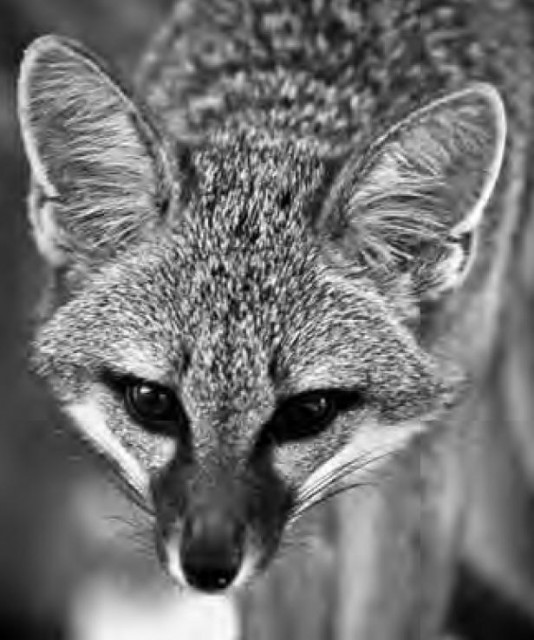Sonoran Desert Arizona and Northern Mexico
T he towering, bristling, water-hoarding saguaro cactus cluster thickly across the desert corrugations of Saguaro National Monument in Arizona, brooding over a mystery. The defining plant of the Sonoran Desert, the largest of the saguaro are 200 years old, 50 feet high (15.24 m), and weigh eight tons. They dominate the park that occupies two sprawling areas of desert on either side of Tucson.
Countless Hollywood westerns and the efforts of generations of landscape photographers have made the saguaro the icon for the very concept of desert. And this towering plant is perfectly adapted to desert conditions with its backwards photosynthesis, stubborn persistence in the face of drought, and ability to store tons of water gathered after the infrequent but fierce desert rainstorms. In turn, the saguaro supports diverse desert ecology (shown in the color insert on page C-4 [bottom]) and has sustained ancient civilizations. It provides a vital resource for desert birds like the white-winged dove, Gila woodpecker, flicker, and elf owl, not to mention an intricate network of insects, lizards, and bacteria that take full advantage of its rich production of seeds, its sweet fruit, and its ability to store vital moisture through months and then years of drought. Moreover, its surprisingly recent adaptation to desert conditions and spread from its isolated Ice Age sanctuaries throughout northern Mexico and southern Arizona have in the process largely defined the extent of the Sonoran Desert, which remains the most diverse and productive of the world's deserts.
Recent efforts to understand the long, slow, surprisingly vulnerable life span of the saguaro have also shed more light on the complex ecological interactions in a desert where every creature lives on the edge of drought and disaster. The story started years ago when botanists compared photos taken before the establishment of the eastern half of the Saguaro National Monument in 1933 with current photos from the same location. They noted a dramatic decline in the number of young saguaros. Normally, it takes the pleated, green-skinned, shallow-rooted saguaro a decade to grow its first inch, half a century to reach 12 feet (3.66 m), and 75 years to sprout branches. Only about one out of the 40 million seeds a saguaro produces in a long lifetime sprouts and produces a saguaro big enough to produce seeds.

Botanists had no idea how to account for the apparent lack of young saguaro in the pictures. Scientists already knew that saguaros germinate in pulses, so that certain wet years produce a bounty crop of sprouts. But they could not find a pattern of wet and dry years that could account for the missing saguaros. Initially, researchers blamed air pollution. They argued that fumes from booming Tucson had stunted the growth of the young saguaros.
But that theory also fell apart when careful measurement in the Saguaro National Monument revealed that most of the missing saguaros were the equivalent of teenagers, about 30 to 120 years old.
That insight solved the mystery and revealed the culprits: cattle and woodcutters. Biologists discovered that few saguaro seedlings took root during the period cattle grazed in what became the monument. Although the federal government established the preserve in 1933, park managers didn't exclude cattle until the 1970s. And, when Americans first arrived in Tucson in the late 1800s, woodcutters quickly cut down most of the mesquite, palo verde, and ironwood trees in the park's eastern section. This eliminated the “nurse trees” whose shade and shelter dramatically increase the chance that a young saguaro will sprout and survive its vulnerable first couple of decades.
Next, settlers stocked the land with too many cattle, which added to the devastation by chomping on any new nurse tree seedlings and trampling the few saguaro sprouts. The picture became clear after biologists compared the patterns of saguaro growth in the heavily disturbed eastern section of Saguaro National Monument with the quieter western section.
The saguaros, which have also nourished desert-dwelling Native American cultures for millennia, show their long, hard history. Droughts cause drooping, looping arms, birds hollow out nesting cavities, accordion-pleated trunks shrink and swell with the rainfall, frost stunts and warps branches. Through it all, they support a complex ecosystem. The massive trunk of a saguaro is speckled with holes, nest cavities hacked out of the thick, thorned, chlorophyll-containing skin of the saguaro by either Gila woodpeckers or flickers. The saguaro seals the injury with a rush of dopamine, the same substance that produces addiction in the brains of heroine addicts or chocoholics, followed by the output of melanin, which also protects frail, human skin from skin cancer. The mix of sap and chemicals produces a hard, brown “boot,” so tough it forms a gourdlike residue in the skeletal remains of a downed saguaro. The woodpeckers occupy their cool, moist nests for a single season, before leaving their digs to a host of other desert refugees, including owls, flycatchers, wrens, martins, starlings, finches, bats, beetles, spiders, and even snakes.